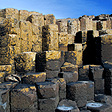DERRY
WALLS WALK - CANNONS & APPRENTICE BOYS
Tour Londonderry's Historic Siege Walls
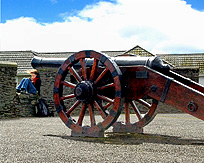 It's come a long way. The city of Derry aka Londonderry has won the bid
to be the first ever UK “City of Culture” for 2013, playing
host to a year-long celebration of culture in the city, opening its doors
to
visitors from
across the world with a contemporary music and dance festival, an international
festival of visual art events, cultural embassies, Irish story telling
verbal arts, and a planned outdoor water borne pageant spectacle on
the River Foyle. But why wait until 2013? Derry is already a fascinating
city with a rich cultural heritage, transforming itself from a difficult
past. Explore the City Walls which have defined much of its troubled
history since the 17th Century.
It's come a long way. The city of Derry aka Londonderry has won the bid
to be the first ever UK “City of Culture” for 2013, playing
host to a year-long celebration of culture in the city, opening its doors
to
visitors from
across the world with a contemporary music and dance festival, an international
festival of visual art events, cultural embassies, Irish story telling
verbal arts, and a planned outdoor water borne pageant spectacle on
the River Foyle. But why wait until 2013? Derry is already a fascinating
city with a rich cultural heritage, transforming itself from a difficult
past. Explore the City Walls which have defined much of its troubled
history since the 17th Century.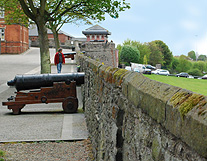 The City of Derry has been one of the longest inhabited places in Ireland
as a settlement at the mouth of the River Foyle, with the first historical
references of the monastery founded by St Columba (Colmcile) in 546 (see St
Columbs Cathedral). The name of Derry was changed to Londonderry during
the Plantation of Ulster beginning in 1613 following the Cromwellian
subjugation of Ireland when the London Guilds built up the city and surrounded
it by heavy defensive walls. The walls were built by “The Honorable,
The Irish Society”, basically the royalist organization, designed
by Captain Edward Doddington of Dungiven and laid out under the supervision
of the surveyor of London, Thomas Raven.
The City of Derry has been one of the longest inhabited places in Ireland
as a settlement at the mouth of the River Foyle, with the first historical
references of the monastery founded by St Columba (Colmcile) in 546 (see St
Columbs Cathedral). The name of Derry was changed to Londonderry during
the Plantation of Ulster beginning in 1613 following the Cromwellian
subjugation of Ireland when the London Guilds built up the city and surrounded
it by heavy defensive walls. The walls were built by “The Honorable,
The Irish Society”, basically the royalist organization, designed
by Captain Edward Doddington of Dungiven and laid out under the supervision
of the surveyor of London, Thomas Raven.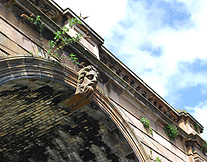 The late 1600s in the Northern Ireland story were defined by the contest
for the English crown between the King James II, a Catholic and the Protestant
Dutch William of Orange married to James’s daughter
Mary. The cities of Londonderry and Inniskillen (see Inniskillen
Castle & Royal Fusiliers), were
the last strongholds against James’s determination to return the
north (Ulster) to Catholicism. As King James marched from Dublin with
an army
of Irish
and French Catholic Jacobites. A group of 13 young guild apprentices
managed to lock the wall gates before the assault and the city held.
An annual ceremonial march of a society commemorating the “Apprentice
Boys” is held on the walls. In the past this has been cause for
trouble between the two sides in a long conflict, but has in the recent
years of reconciliation been free of strife.
The late 1600s in the Northern Ireland story were defined by the contest
for the English crown between the King James II, a Catholic and the Protestant
Dutch William of Orange married to James’s daughter
Mary. The cities of Londonderry and Inniskillen (see Inniskillen
Castle & Royal Fusiliers), were
the last strongholds against James’s determination to return the
north (Ulster) to Catholicism. As King James marched from Dublin with
an army
of Irish
and French Catholic Jacobites. A group of 13 young guild apprentices
managed to lock the wall gates before the assault and the city held.
An annual ceremonial march of a society commemorating the “Apprentice
Boys” is held on the walls. In the past this has been cause for
trouble between the two sides in a long conflict, but has in the recent
years of reconciliation been free of strife.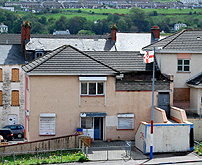 The old city of Derry is within the walls, while most of the modern city
lies beyond, the Catholic neighborhoods on one side and Protestant on
the other, marked by their colors. The walls are defined by the angled
bastions protruding from the corners deigned to provide clear fields
of fire along the length of the wall. The bastions were originally named
in 1622 to honor the Protestant English settlers like “Lord Dowcra’s
Bulwark” or the “Governor of the Plantation Bulwark”.
During the siege of Londonderry is 1689 the bastions came to be renamed
with a more topical tone, “Coward’s Bastion” or Hangman’s
Bastion”. The Derry city walls originally had four gates, but over
time the gates were changed or moved and now are six. Look to the three
larger gates for the original sculpted heads of river gods, added to
by the heads of the heroes of the siege.
The old city of Derry is within the walls, while most of the modern city
lies beyond, the Catholic neighborhoods on one side and Protestant on
the other, marked by their colors. The walls are defined by the angled
bastions protruding from the corners deigned to provide clear fields
of fire along the length of the wall. The bastions were originally named
in 1622 to honor the Protestant English settlers like “Lord Dowcra’s
Bulwark” or the “Governor of the Plantation Bulwark”.
During the siege of Londonderry is 1689 the bastions came to be renamed
with a more topical tone, “Coward’s Bastion” or Hangman’s
Bastion”. The Derry city walls originally had four gates, but over
time the gates were changed or moved and now are six. Look to the three
larger gates for the original sculpted heads of river gods, added to
by the heads of the heroes of the siege. 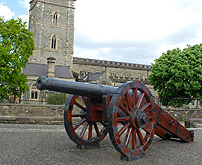 The
city of Londonderry holds claim to the largest collection of cannons
in Europe of which the specific origins are known, essentially
because
they
are all labeled and have remained pretty much in place on the walls,
many of them fired in the two sieges of the city in the 1600s. There
are twenty-four. Near the Shipquay Gate facing the Guildhall are two
of the earliest examples of Elizabethan cannons from 1590 and each marked
with the “Rose” of the Tudors. On the bastions are cannons
from 1642 with the names of London companies of the guilds, a sort of
sponsor branding. At the far end on the Double Bastion is the massive “Roaring
Meg”.
The
city of Londonderry holds claim to the largest collection of cannons
in Europe of which the specific origins are known, essentially
because
they
are all labeled and have remained pretty much in place on the walls,
many of them fired in the two sieges of the city in the 1600s. There
are twenty-four. Near the Shipquay Gate facing the Guildhall are two
of the earliest examples of Elizabethan cannons from 1590 and each marked
with the “Rose” of the Tudors. On the bastions are cannons
from 1642 with the names of London companies of the guilds, a sort of
sponsor branding. At the far end on the Double Bastion is the massive “Roaring
Meg”.
Guildhall
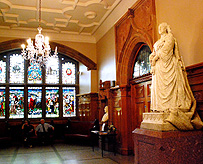 Just outside the walls through the Shipquay Gate is the iconic Guildhall,
built in Victorian era neo-Gothic and faux Tudor style of red sandstone
in 1887, still the seat of the city government. bearing the scars of
the conflict which festered for over 300 years. The Guildhall of Derry
has some of the finest examples of stained glass in Ireland, though
most of it had to be painstakingly restored after a number of bomb
attacks
in 1972 during the height of the modern conflict. Look closely at the
statue of Queen Victoria and you’ll find where the stone was chipped
and broken by bomb blasts. The bust of King George the VII across the
foyer got it even worse. His head was severed by a blast, with the crack
now repaired but still visible, I suppose a symbolic victory, the beheading
of an English King, if only a marble one.
Just outside the walls through the Shipquay Gate is the iconic Guildhall,
built in Victorian era neo-Gothic and faux Tudor style of red sandstone
in 1887, still the seat of the city government. bearing the scars of
the conflict which festered for over 300 years. The Guildhall of Derry
has some of the finest examples of stained glass in Ireland, though
most of it had to be painstakingly restored after a number of bomb
attacks
in 1972 during the height of the modern conflict. Look closely at the
statue of Queen Victoria and you’ll find where the stone was chipped
and broken by bomb blasts. The bust of King George the VII across the
foyer got it even worse. His head was severed by a blast, with the crack
now repaired but still visible, I suppose a symbolic victory, the beheading
of an English King, if only a marble one.
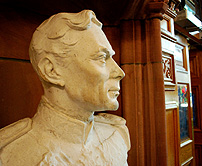 If this story is complex but fascinating and a bit intimidating, stop
by the Derry Tourist Information Center and arrange for a Guided Walking
Tour, to hear it in a lilting Irish accent. If you can't wait until
2013, try the River Inn Pub for music and drinking, it's been around
since before the siege, and should you get into a conversation
with a local about the name of the city, it depends on who you're talking
to. © Bargain
Travel Europe
If this story is complex but fascinating and a bit intimidating, stop
by the Derry Tourist Information Center and arrange for a Guided Walking
Tour, to hear it in a lilting Irish accent. If you can't wait until
2013, try the River Inn Pub for music and drinking, it's been around
since before the siege, and should you get into a conversation
with a local about the name of the city, it depends on who you're talking
to. © Bargain
Travel Europe
Find best travel deals in Northern Ireland on TripAdvisor
Web
Info
Derry
Tourism
These articles are copyrighted and the sole property of Bargain Travel Europe and WLPV, LLC. and may not be copied or reprinted without permission.
SEE ALSO
DERRY TOWER MUSEUM - THE SPANISH ARMADA
GRANT HOMESTEAD – COUNTY TYRONE
CASTLE COOLE & FLORENCE COURT MANOR

